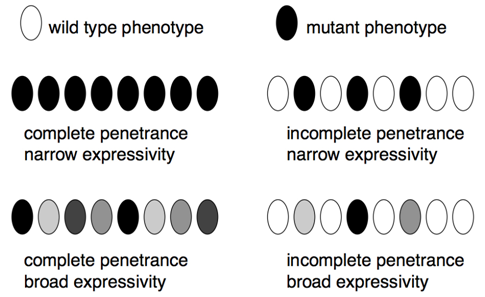3.6: Phenotypes May Not Be As Expected from the Genotype
- Page ID
- 4020
Environmental Factors
The phenotypes described thus far have a nearly perfect correlation with their associated genotypes; in other words an individual with a particular genotype always has the expected phenotype. However, many phenotypes are not determined entirely by genotype alone. They are instead determined by an interaction between genotype and non-genetic, environmental factors and can be conceptualized in the following relationship:
\[\mathrm{Genotype + Environment ⇒ Phenotype \hspace{30px} (G + E ⇒ P)}\]
Or:
\[\mathrm{Genotype + Environment + \overset{Genetics\: and\: Environment}{Interaction_{GE}} ⇒ Phenotype \hspace{30px} (G + E + I_{GE} ⇒ P)}\]
This interaction is especially relevant in the study of economically important phenotypes, such as human diseases or agricultural productivity. For example, a particular genotype may pre-dispose an individual to cancer, but cancer may only develop if the individual is exposed to certain DNA-damaging chemicals. Therefore, not all individuals with the particular genotype will develop the cancer phenotype.
Penetrance and Expressivity
The terms penetrance and expressivity are also useful to describe the relationship between certain genotypes and their phenotypes.
- Penetrance is the proportion of individuals (usually expressed as a percentage) with a particular genotype that display a corresponding phenotype (Figure \(\PageIndex{16}\)). Because all pea plants that are homozygous for the allele for white flowers (e.g. aa in Figure \(\PageIndex{3}\)) actually have white flowers, this genotype is completely penetrant. In contrast, many human genetic diseases are incompletely penetrant, since not all individuals with the disease genotype actually develop symptoms associated with the disease.
- Expressivity describes the variability in mutant phenotypes observed in individuals with a particular phenotype (Figure \(\PageIndex{16}\)). Many human genetic diseases provide examples of broad expressivity, since individuals with the same genotypes may vary greatly in the severity of their symptoms. Incomplete penetrance and broad expressivity are due to random chance, non-genetic (environmental), and genetic factors (mutations in other genes).



